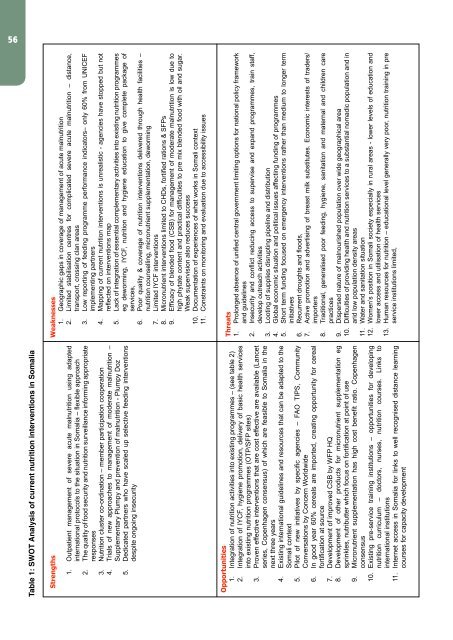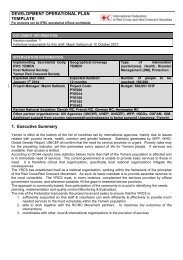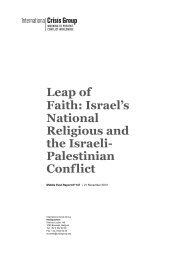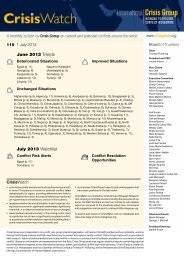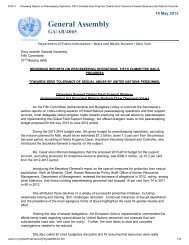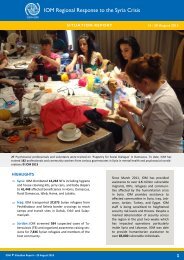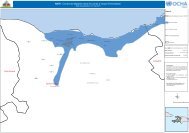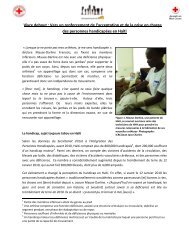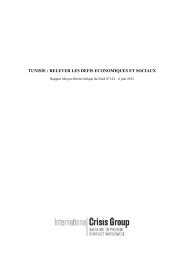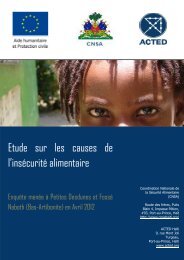SOMALI NUTRITION STRATEGY 2011 – 2013 - ReliefWeb
SOMALI NUTRITION STRATEGY 2011 – 2013 - ReliefWeb
SOMALI NUTRITION STRATEGY 2011 – 2013 - ReliefWeb
Create successful ePaper yourself
Turn your PDF publications into a flip-book with our unique Google optimized e-Paper software.
56<br />
Table 1: SWOT Analysis of current nutrition interventions in Somalia<br />
Strengths<br />
1. Outpatient management of severe acute malnutrition using adapted<br />
international protocols to the situation in Somalia <strong>–</strong> flexible approach<br />
2. The quality of food security and nutrition surveillance informing appropriate<br />
responses<br />
3. Nutrition cluster co-ordination <strong>–</strong> member participation cooperation<br />
4. Trials of new approaches to management of moderate malnutrition <strong>–</strong><br />
Supplementary Plumpy and prevention of malnutrition - Plumpy Doz<br />
5. Dedicated partners who have scaled up selective feeding interventions<br />
despite ongoing insecurity<br />
Opportunities<br />
1. Integration of nutrition activities into existing programmes <strong>–</strong> (see table 2)<br />
2. Integration of IYCF, hygiene promotion, delivery of basic health services<br />
into existing nutrition programmes (OTP/SFP sites)<br />
3. Proven effective interventions that are cost effective are available (Lancet<br />
series, Copenhagen consensus) of which are feasible to Somalia in the<br />
next three years<br />
4. Existing international guidelines and resources that can be adapted to the<br />
Somali context<br />
5. Pilot of new initiatives by specific agencies <strong>–</strong> FAO TIPS, Community<br />
Conversations by Concern Worldwide<br />
6. In good year 60% cereals are imported, creating opportunity for cereal<br />
fortification at source<br />
7. Development of improved CSB by WFP HQ<br />
8. Development of other products for micronutrient supplementation eg<br />
sprinkles, nutributter which focus on fortification at point of use<br />
9. Micronutrient supplementation has high cost benefit ratio. Copenhagen<br />
consensus<br />
10. Existing pre-service training institutions <strong>–</strong> opportunities for developing<br />
nutrition curriculum <strong>–</strong> doctors, nurses, nutrition courses. Links to<br />
international institutions<br />
11. Internet access in Somalia for links to well recognised distance learning<br />
courses for capacity development<br />
Weaknesses<br />
1. Geographic gaps in coverage of management of acute malnutrition<br />
2. Limited stabilisation centres for complicated severe acute malnutrition <strong>–</strong> distance,<br />
transport, crossing clan areas<br />
3. Low reporting of feeding programme performance indicators<strong>–</strong> only 60% from UNICEF<br />
implementing partners<br />
4. Mapping of current nutrition interventions is unrealistic - agencies have stopped but not<br />
reflected on interventions map<br />
5. Lack of integration of essential complementary activities into existing nutrition programmes<br />
eg deworming, IYCF, nutrition and hygiene education to give complete package of<br />
services,<br />
6. Poor quality & coverage of nutrition interventions delivered through health facilities <strong>–</strong><br />
nutrition counselling, micronutrient supplementation, deworming<br />
7. Limited IYCF interventions<br />
8. Micronutrient interventions limited to CHDs, fortified rations & SFPs<br />
9. Efficacy of blended food (CSB) for management of moderate malnutrition is low due to<br />
high phytate content and practical difficulties to pre mix blended food with oil and sugar.<br />
Weak supervision also reduces success<br />
10. Documentation of experiences of what works in Somali context<br />
11. Constraints on monitoring and evaluation due to accessibility issues<br />
Threats<br />
1. Prolonged absence of unified central government limiting options for national policy framework<br />
and guidelines<br />
2. Insecurity and conflict reducing access to supervise and expand programmes, train staff,<br />
develop outreach activities<br />
3. Looting of supplies disrupting pipeline and distribution<br />
4. Global economic situation and political issues affecting funding of programmes<br />
5. Short term funding focused on emergency interventions rather than medium to longer term<br />
initiatives<br />
6. Recurrent droughts and floods,<br />
7. Active promotion and advertising of breast milk substitutes. Economic interests of traders/<br />
importers<br />
8. Traditional, generalised poor feeding, hygiene, sanitation and maternal and children care<br />
practices<br />
9. Dispersed nature of malnourished population over wide geographical area<br />
10. Difficulties of providing health and nutrition services to a substantial nomadic population and in<br />
arid low population density areas<br />
11. Water and sanitation situation<br />
12. Women’s position in Somali society especially in rural areas - lower levels of education and<br />
lower access and utilisation of health services<br />
13. Human resources for nutrition <strong>–</strong> educational level generally very poor, nutrition training in pre<br />
service institutions limited,


